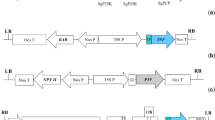Abstract
Previously we demonstrated that inhibition of replication-associated protein (Rep) binding to its replication origin by artificial zinc-finger proteins (AZPs) is a powerful method to prevent plant virus infection in vivo. In the present study, we applied the AZP technology to Tomato yellow leaf curl virus (TYLCV), which is a limiting factor in tomato cultivation worldwide. First, we determined 5′-ATCGGTGT ATCGGTGT-3′ in the 195-bp intergenic region of the TYLCV-Israel strain, a strain reported first among TYLCV strains, as the Rep-binding site by gel shift assays. We then constructed a 6-finger AZP that bound to a 19-bp DNA including the Rep-binding site. We demonstrated that the binding affinity of the AZP was >1,000-fold greater than that of Rep and that the AZP inhibited Rep binding completely in vitro. Because the binding capability of the AZP was same as that of the AZP previously designed for geminivirus-resistant Arabidopsis thaliana, we predict that the present AZP will prevent TYLCV infection in vivo.





Similar content being viewed by others
References
Abhary, M., Patil, B. L., & Fauquet, C. M. (2007). Molecular biodiversity, taxonomy, and nomenclature of tomato yellow leaf curl-like viruses. In H. Czosnek (Ed.), Tomato yellow leaf curl virus disease (pp. 85–118). Dordrecht, South Holland: Springer.
Anfoka, G. (2007). Gene silencing of tomato yellow leaf curl virus. In H. Czosnek (Ed.), Tomato yellow leaf curl virus disease (pp. 391–405). Dordrecht, South Holland: Springer.
Fontes, E. P. B., Eagle, P. A., Sipe, P. S., Luckow, V. A., & Hanley-Bowdoin, L. (1994). Interaction between a geminivirus replication protein and origin DNA is essential for viral replication. Journal of Biological Chemistry, 269, 8459–8465.
Fontes, E. P. B., Gladfelter, H. J., Schaffer, R. L., Petty, I. T. D., & Hanley-Bowdoin, L. (1994). Geminivirus replication origins have a modular organization. Plant Cell, 6, 405–415.
Fontes, E. P. B., Luckow, V. A., & Hanley-Bowdoin, L. (1992). A geminivirus replication protein is a sequence-specific DNA binding protein. Plant Cell, 4, 597–608.
Hanley-Bowdoin, L., Settlage, S. B., Orozco, B. M., Nagar, S., & Robertson, D. (2000). Geminiviruses: Models for plant DNA replication, transcription, and cell cycle regulation. Critical Reviews in Biochemistry and Molecular Biology, 35, 105–140.
Kheyr-Pour, A., Gronenborn, B., & Czosner, H. (1994). Agroinoculation of tomato yellow leaf curl virus (TYLCV) overcomes the virus resistance of wild Lycopersicon species. Plant Breeding, 112, 228–233.
Kim, C. A., & Berg, J. M. (1996). A 2.2 Å resolution crystal structure of a designed zinc finger protein bound to DNA. Nature Structural Biology, 11, 940–945.
Kim, J.-S., & Pabo, C. O. (1998). Getting a handhold on DNA: Design of poly-zinc finger proteins with femtomolar dissociation constants. Proceedings of the National academy of Sciences of the United States of America, 95, 2812–2817.
Orozco, B. M., & Hanley-Bowdoin, L. (1998). Conserved sequence and structural motifs contribute to the DNA binding and cleavage activities of a geminivirus replication protein. Journal of Biological Chemistry, 273, 24448–24456.
Orozco, B. M., Kong, L.-J., Batts, L. A., Elledge, S., & Hanley-Bowdoin, L. (2000). The multifunctional character of a geminivirus replication protein is reflected by its complex oligomerization properties. Journal of Biological Chemistry, 275, 6114–6122.
Sera, T. (2005). Inhibition of virus DNA replication by artificial zinc-finger proteins. Journal of Virology, 79, 2614–2619.
Sera, T., & Uranga, C. (2002). Rational design of artificial zinc-finger proteins using a nondegenerate recognition code table. Biochemistry, 41, 7074–7081.
Acknowledgments
We thank Tadayuki Imanaka and Haruyuki Atomi for the use of their DNA sequencer. This work was supported by a grant from the Program for Promotion of Basic Research Activities for Innovative Biosciences (PROBRAIN) to T.S.
Author information
Authors and Affiliations
Corresponding author
Rights and permissions
About this article
Cite this article
Mori, T., Takenaka, K., Domoto, F. et al. Inhibition of Binding of Tomato Yellow Leaf Curl Virus Rep to its Replication Origin by Artificial Zinc-Finger Protein. Mol Biotechnol 54, 198–203 (2013). https://doi.org/10.1007/s12033-012-9552-5
Published:
Issue Date:
DOI: https://doi.org/10.1007/s12033-012-9552-5




